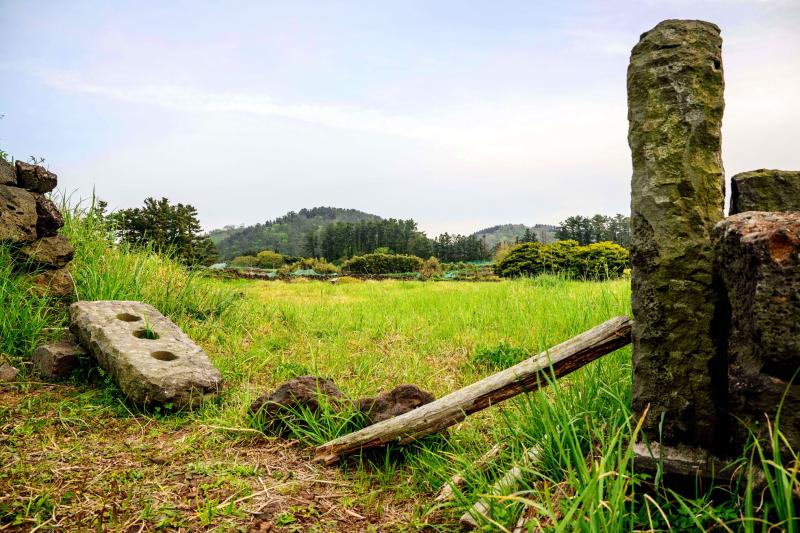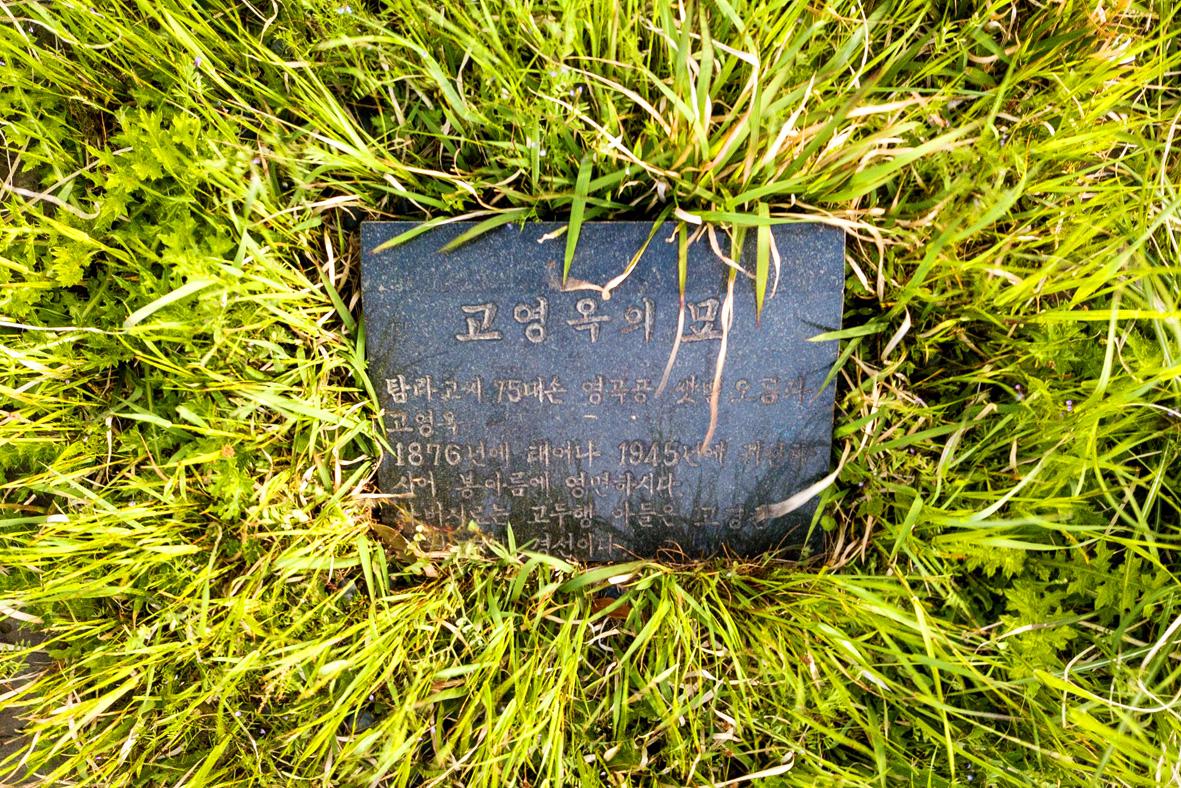North Korea’s leader Kim Jong-un has threatened Seoul with fiery destruction, but as a remote graveyard on a resort island shows, he has closer links to the South than he might like to admit.
At a cemetery in a hard-to-find corner of South Korea’s Jeju island, there are 13 tombstones bearing the Ko family name — Kim’s relatives through his mother, Ko Yong-hui.
Jong-un is the third member of the Kim family to rule North Korea, following in the footsteps of his father and grandfather — what official hagiography calls the “Paektu bloodline.”

Photo: AFP
But the Jeju graves tell a wider story.
Kim’s mother was born in Osaka in 1952 to a native Jeju islander who emigrated to Japan in 1929, when the Korean peninsula was under Tokyo’s colonial rule.
Many of her family, including Kim’s maternal great-grandfather, are buried on Jeju, their overgrown graves a stark contrast to Pyongyang’s Kumsusan Palace of the Sun, where the embalmed bodies of Kim’s father and grandfather Kim Il-sung lie in state.

Photo: AFP
After Kim came to power in 2011 following the death of his father Kim Jong-il, many experts highlighted his mother’s South Korean and Japanese heritage. Pyongyang has never confirmed it.
The regime “must have feared confirmation would undermine its legitimacy,” said Cheong Seong-chang of the Center for North Korea Studies at the Sejong Institute.
The Kim dynasty bases its claim to power on Kim Il-sung’s role as a guerrilla fighter driving out Japan and winning Korea its independence in 1945.
“Korea-Japan heritage runs directly counter to the North Korean myth of its leadership,” Cheong said.
KIM’S MOTHER
Kim’s mother grew up in the Japanese port city of Osaka, but her family moved to North Korea in the 1960s as part of a decades-long repatriation program by Pyongyang.
The scheme urged ethnic Koreans living in Japan to move to North Korea, part of a drive to “claim supremacy” over the South, said Park Chul-hyun, a novelist and columnist in Tokyo.
“The North saw the Korean-Japanese community as a strategic battleground,” he said, and managed to convince nearly 100,000 ethnic Koreans to relocate to the “socialist paradise.”
The Ko family answered the call, and lived a relatively normal life in the North until their eldest daughter caught the eye of the country’s heir apparent.
Experts believe that Ko, who was a performer with the Mansudae Art Troupe of musicians and dancers, first met Kim Jong-il in Pyongyang in 1972.
She would become his partner in 1975, experts say, and although there is no official record of their marriage the pair had three children. She died in 2004.
“There has been nothing about Ko Yong-hui in official state media,” said Rachel Min-young Lee, a non-resident fellow with the 38 North Program at the Washington-based Stimson Center.
There is not much in state media about Kim Jong-un’s background and heritage generally beyond attempts to show he is the legitimate heir to the Mount Paektu legacy, she added.
EMPTY GRAVE
South Korean media discovered the Ko family graves on Jeju in 2014 — one of the first real confirmations of Kim Jong-un’s South Korean ancestry.
At that time, there was a plaque — known as an “empty grave” in the South — honoring Kim’s maternal grandfather Ko Gyong-taek, even though he died and was buried in the North.
“Born in 1913 and moved to Japan in 1929. He passed away in 1999,” read the plaque, a custom which allows family members to perform ancestor rites even if the body is not present.
The plaque was not there when AFP visited the Jeju graveyard in April.
It had been removed by a distant relative of Kim Jong-un, who was shocked by the media attention and feared the grave would be vandalized, the daily Chosun Ilbo reported.
He said his family “knew nothing about the relation to Kim Jong-un”, prior to the media discovery, the report said.

Many people noticed the flood of pro-China propaganda across a number of venues in recent weeks that looks like a coordinated assault on US Taiwan policy. It does look like an effort intended to influence the US before the meeting between US President Donald Trump and Chinese dictator Xi Jinping (習近平) over the weekend. Jennifer Kavanagh’s piece in the New York Times in September appears to be the opening strike of the current campaign. She followed up last week in the Lowy Interpreter, blaming the US for causing the PRC to escalate in the Philippines and Taiwan, saying that as

Taiwan can often feel woefully behind on global trends, from fashion to food, and influences can sometimes feel like the last on the metaphorical bandwagon. In the West, suddenly every burger is being smashed and honey has become “hot” and we’re all drinking orange wine. But it took a good while for a smash burger in Taipei to come across my radar. For the uninitiated, a smash burger is, well, a normal burger patty but smashed flat. Originally, I didn’t understand. Surely the best part of a burger is the thick patty with all the juiciness of the beef, the

This year’s Miss Universe in Thailand has been marred by ugly drama, with allegations of an insult to a beauty queen’s intellect, a walkout by pageant contestants and a tearful tantrum by the host. More than 120 women from across the world have gathered in Thailand, vying to be crowned Miss Universe in a contest considered one of the “big four” of global beauty pageants. But the runup has been dominated by the off-stage antics of the coiffed contestants and their Thai hosts, escalating into a feminist firestorm drawing the attention of Mexico’s president. On Tuesday, Mexican delegate Fatima Bosch staged a

Would you eat lab-grown chocolate? I requested a sample from California Cultured, a Sacramento-based company. Its chocolate, not yet commercially available, is made with techniques that have previously been used to synthesize other bioactive products like certain plant-derived pharmaceuticals for commercial sale. A few days later, it arrives. The morsel, barely bigger than a coffee bean, is supposed to be the flavor equivalent of a 70 percent to 80 percent dark chocolate. I tear open its sealed packet and a chocolatey aroma escapes — so far, so good. I pop it in my mouth. Slightly waxy and distinctly bitter, it boasts those bright,